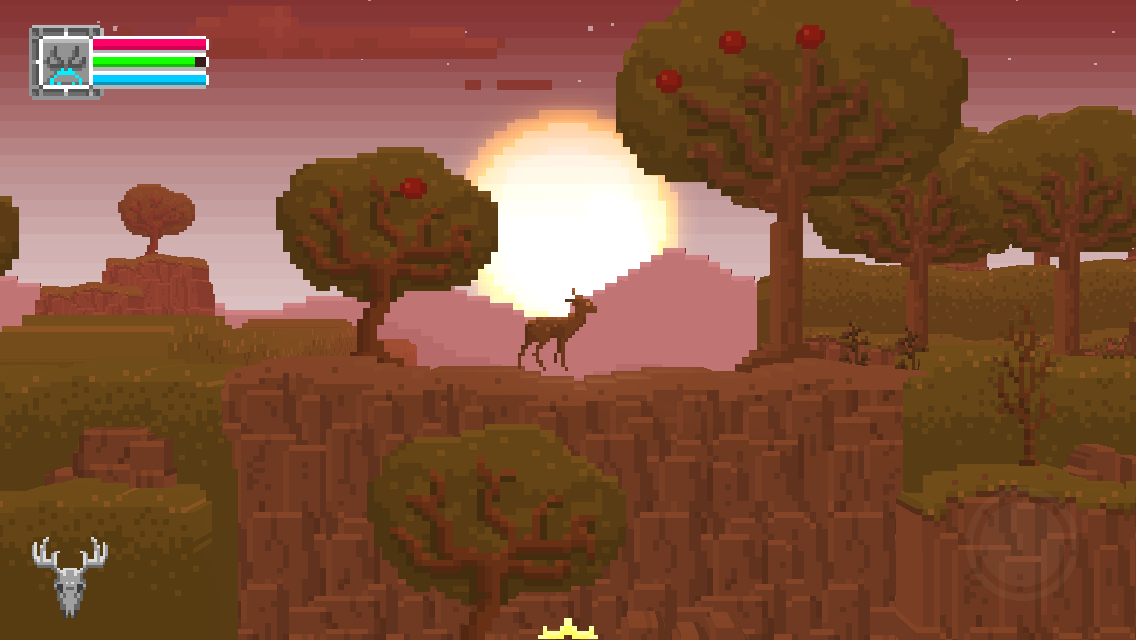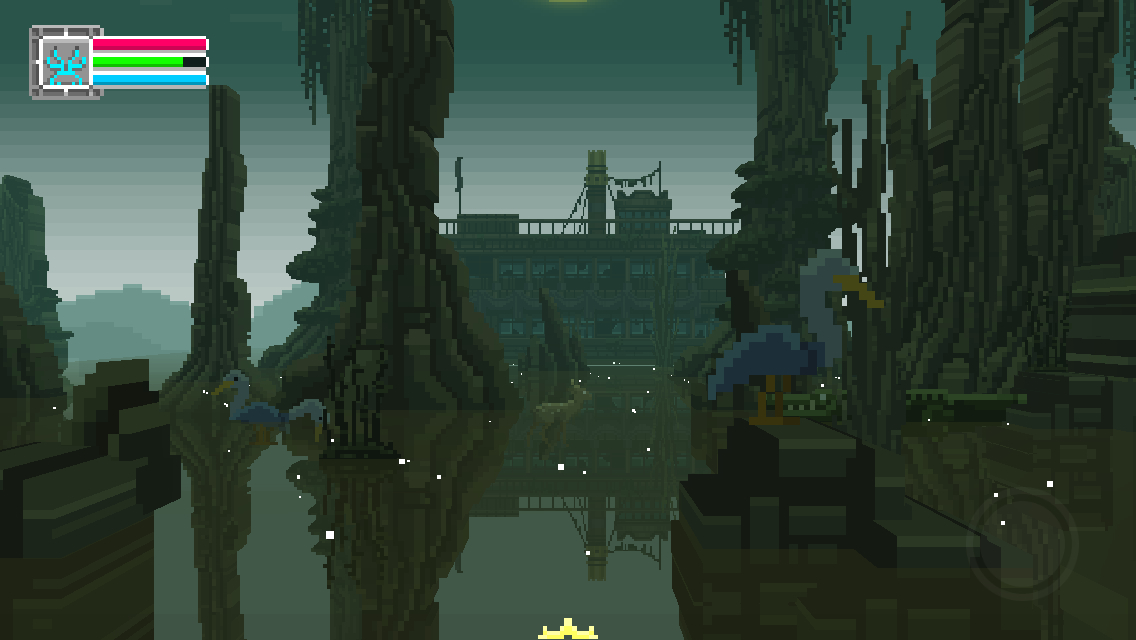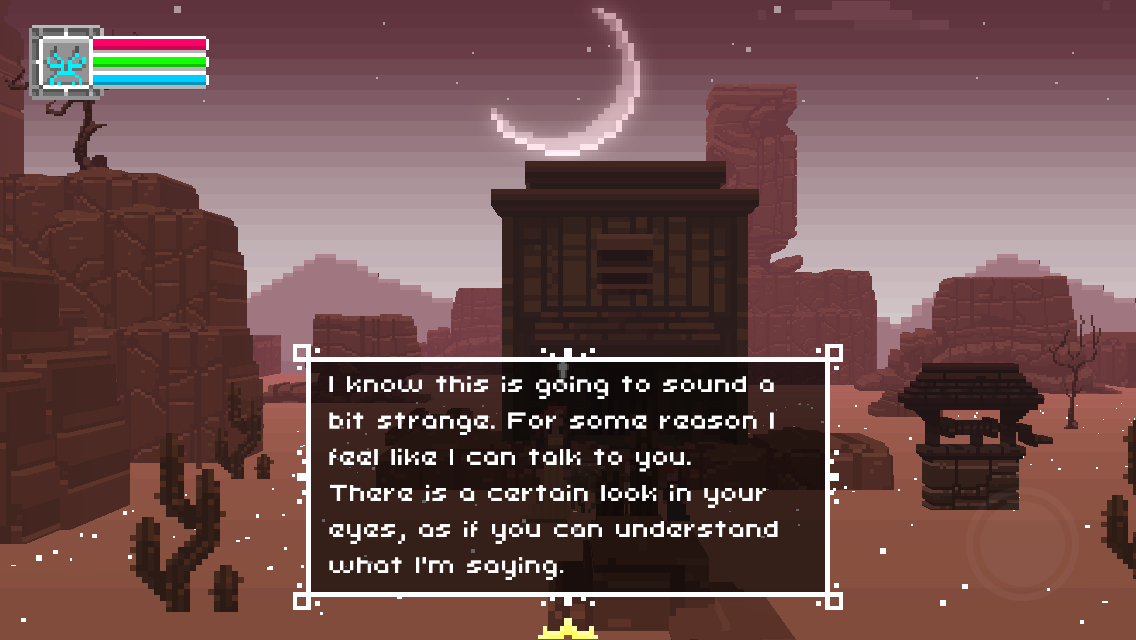 There are moments in The Deer God ($4.99) that are so beautiful and feel so right, that I want to give a running, leaping series of high-fives to the developers. Its sense of style is outstanding, making for one of those games where you sometimes just want to stop and take in the view. When you’re running free and clear, leaping over chasms without missing a beat, the game just works in a pure way. The steady sound of your hoofbeats, the rise and eventual fall of the sun on each day, the rolling scenery, the zen-like state of tapping to leap over whatever gets in your way, this is when The Deer God is at its utmost. But there’s another side to this pretty little game, and it’s most unlike a deer: clumsy, ugly, and lacking in gracefulness. This one is a real mixed bag, and while I could see people falling hard for it over its worthier merits, the many issues with the game really drag it down for me.
There are moments in The Deer God ($4.99) that are so beautiful and feel so right, that I want to give a running, leaping series of high-fives to the developers. Its sense of style is outstanding, making for one of those games where you sometimes just want to stop and take in the view. When you’re running free and clear, leaping over chasms without missing a beat, the game just works in a pure way. The steady sound of your hoofbeats, the rise and eventual fall of the sun on each day, the rolling scenery, the zen-like state of tapping to leap over whatever gets in your way, this is when The Deer God is at its utmost. But there’s another side to this pretty little game, and it’s most unlike a deer: clumsy, ugly, and lacking in gracefulness. This one is a real mixed bag, and while I could see people falling hard for it over its worthier merits, the many issues with the game really drag it down for me.

The premise is clever. A deer hunter is killed by wolves during a storm, and the Deer God decides to give him a chance to make up for his crimes in life by reincarnating him as a deer. Making up for his crimes seems to entail collecting a bunch of relics and killing animals the Deer God has arbitrarily decided are bad guys. The game itself is a side-scrolling platformer, albeit one with a few twists. Most obviously, the world is procedurally-generated when you start playing it, and though it won’t change from life-to-life, enemy placement will. There aren’t any discrete levels in the traditional sense, but you’ll loop around the same sections until you find and complete the mission in that area. The missions vary, but most of them involve finding an item somewhere in that section and bringing it back. That item’s placement is also procedurally-generated, so it could be ten seconds away from the quest-giver, or it might be really far. In addition to quest items, you can also find helpful items that you can use whenever you like. They run the gamut from healing, to invincibility, to giving you a temporary super jump ability. Your deer will earn new abilities as you go, some as part of the story, others connected to your karma meter. You’ll also run into bosses now and then, and they can be quite the challenge.
There are two difficulty settings. In hardcore mode, you have a set number of lives. You can earn more through various means, but if you happen to run out, that’s it. Game over. The normal setting effectively gives you unlimited lives, though you’ll respawn as a weak little fawn if you run out of lives. I’d recommend going for the latter, as you will be dying a lot, and only some of those will be your fault. There are a lot of reasons for that, but I’ll go into that shortly. If you manage to stay alive, your deer will grow into adulthood, with each stage granting more strength until you’re strong enough to handle even hunters. If you die with lives in stock, you’ll reappear near where you died. If you fall on your “last" life in normal mode, you’ll start back at your last save point. Sometimes those save points land in irritating places, and there are some bugs in the current version that can put them in showstopping locations, such as in the middle of some of the geometry.

The current version of The Deer God suffers from a lot of bugs. Sometimes you’ll clip into objects and be unable to escape. Sometimes you’ll go sailing off a cliff only to find nothing waiting beyond, and be forced to quit back to the menu. I didn’t run into any out-and-out crashes, but I had to quit back to the title screen an awful lot due to clipping issues. Sometimes events that are supposed to trigger don’t, again forcing you to restart the app and hope for a luckier outcome. The game is already fairly difficult, and losing progress in this way is frankly aggravating. While playing the game for this review, I had to completely restart the game from scratch after nearly finishing it, simply because my save file would only spawn me in a glitchy state that prevented me from moving forward. I know Crescent Moon are hard at work fixing these bugs, so with any luck, this paragraph will be obsolete before too long (Since this was written, an update was submitted that apparently fixes many of these bugs.). It’s still worth keeping in mind if you intend to take a chance on the game in the meantime, though.
Unfortunately, The Deer God‘s problems run deeper than bugs. As good as it feels to run and jump around, just about everything else you’ll do tends to be awkward and unpleasant. Combat is the worst offender. The default control layout has you swiping to attack, a gesture which simply doesn’t work well here. Not only is it hard to pull off, it requires you to block the main play area. Since your deer’s attack is a dash, it’s easy to make fatal mistakes, especially when you can’t see exactly what you’re doing. That’s made worse by the beautiful color palette. It looks great, but in terms of functionality, it stinks. Your deer will blend into so many of the game’s backgrounds, and the enemies will, too. You probably won’t even notice many of the enemies until they’ve already hit you. The collision detection is just fussy enough that enemies can bounce you for heavy damage if you get caught in the wrong place, and it’s a rare attack that doesn’t result in your deer also taking damage. You can switch off swiping to attack, which will give you a button to use instead. That works better, but you’ll still run into many of the same issues.

So, combat isn’t very good, but apart from bosses, you can probably just ignore it, right? After all, you’re a deer. Plus, the whole karma thing probably dictates that you shouldn’t be killing every bit of wildlife you come across. You would think that, anyway, but the karma system ends up forcing you to fight. Killing aggressive animals, including snakes, boars, skunks, and others, will get you some positive karma, while hurting or killing friendly animals will earn you negative karma. You’ll earn new special powers as you load up on karma, and since positive and negative operate on separate continuums, you don’t have to worry about the occasional bit of evil-doing. What you do want to make sure you do is to keep the good karma higher than the bad karma. If you don’t, you’ll resurrect as another animal instead of a deer on every other life. That animal will sometimes be unable to progress, forcing you to starve to death to come back as a deer and move on. In other cases, they will be able to navigate just fine, but even the best of them lack the necessary qualities to continue. This is pretty neat the first couple of times it happens, but it gets old really fast.
You can try to avoid building bad karma, but you’ll get “credit" for a good animal’s death even if you don’t have a hand in it. If they careen off a ledge and die, congratulations, you just earned some bad karma. If you accidentally butt into them because they walked in the way of your attack, you’re getting some bad karma. So you pretty much have to kill the bad animals to make sure you’re outpacing your bad karma growth, so that you don’t have to waste away every other life on a weird reincarnation. No, there’s no two ways about it, you’ll have to deal with the combat unless you want a greater annoyance to deal with. The boss fights are unique challenges, rarely making use of straight-forward attacks. Instead, you’ll have to find the special way to defeat them, usually involving some aspect of the environment. You’ll still have to deal with clunky collision and the occasional awkward attack sequence, but the boss challenges feel more like you’re fighting an intended challenge rather than one that springs out of technical issues.

Slightly less irritating, but still worth mentioning, is the platforming. There are lots of places where you need to jump between small platforms, and missing your mark will generally mean death from spikes or whatever other soup-du-jour waits below. This can be a headache for two reasons. First, your deer being a deer, when he starts to move, he really moves. It’s a problem when you’ve only got a small foothold, and if you’re still using swipe to attack, it’s possible to misfire in these situations and fall to your death. The other issue is the camera. It’s very cinematic, but it doesn’t always do a good job of keeping up with your deer or showing the information about your surroundings that you need to survive. It’s so much fun to gallop ahead, jumping in a sweet rhythm, but in practice, you’ll die quickly if you don’t take it slowly around the platforming areas. You have to edge your way down carefully until you see an actual landing spot, because the camera will not give you time to react if you just jump for it. I think the camera needs to be pulled back a bit, but doing so might make details hard to make out due to the subdued palette.
Then there are elements that feel vestigial, like nobody could quite figure out how to integrate them properly but left them in anyway. For example, you have a hunger gauge, which is likely a nod to the roguelike genre. You’ll need to make sure you find and eat enough food to keep your meter up, or else your health will slowly start to drain. The idea here is probably to keep the player moving, because food isn’t hard to come by provided you keep going forward. My question is why we feel the need to rush the player? I guess it’s so that you don’t just sit in one place waiting for time to level your deer up to its adult state, but given the amount of real time that would take, I doubt it would really break the game. Most of the time, there’s so much food around you won’t even need to consider it. The gauge would add tension to boss fights, but there’s usually an auto-replenishing source of chow in the boss’s lair. Starvation proves to be a useful self-destruct mechanism if you get stuck somewhere you can’t escape from, I suppose. Past that, the main effect this mechanic has on the gameplay is when your deer slows down to eat food sources while you’re trying to run away from something dangerous, or munches on some flowers at the edge of a cliff just when you were about to jump.

Given its place in the narrative, the karma system feels poorly-handled, as well. The points you earn feel arbitrary, and indeed, so long as you keep your positive karma higher, doing the things the game deems bad seems to have no effect. Has my hunter really learned something about respect for nature by killing more ugly animals than cute ones? And while I loved the idea of reincarnating me as another animal the first time the game did it, the fact that it happens so frequently, until you kill enough snakes or what-have-you to get your positive karma back up, takes the punch out of it. Plus, some of the animal I reincarnated as were actually better than the deer. Worst of all, it doesn’t seem like karma actually matters in the end. There’s more than one ending, but instead of relying on your karma total, it’s simply down to a choice. In the end, it feels like the karma system is only there to keep you fighting enemies instead of running from them. Given the themes the game is reaching for, that’s a disappointing outcome.
There are plenty of moments in the game that are so dazzling, it’s easy to forget the problems. This is an incredibly gorgeous game, combining pixel art with a strong sense of 3D space that lends it a look like no other. Days roll into nights, the sun gives way to the moon, seasons change, and new areas sprawl out before you. It’s almost worth the constant irritations and meaningless mechanics just for those rare moments when the game takes your breath away. The wasted karma system aside, the game does a nice job of telling a simple yet moving story. I’m not entirely convinced our hunter deserved the wringing the Deer God put him through, but it’s still a powerful journey. Make sure you look around and find all of the secret places tucked around the world. There are little scraps of story that you can miss that contribute greatly to the weight of the conclusion. If you fall into The Deer God‘s enchanting atmosphere and get entranced by its understated narrative, there’s a good chance you’ll love this game enough to forgive its weaker points, significant though they may be.
I wish I could say that applied to me, though. I can appreciate the things The Deer God does well, and I don’t regret playing it, because those moments were stunning. But it wasn’t quite enough to balance out the clunky action, the inadequate camera, and the numerous bugs. There’s something truly special at the core of The Deer God, but it’s doled out in moments of sublime pleasure surrounded by long stretches of frustration and disappointment.
